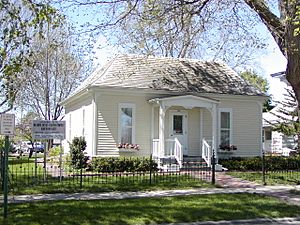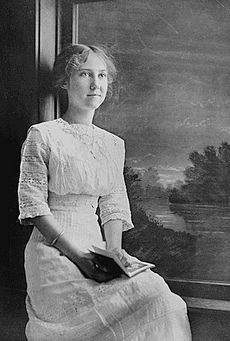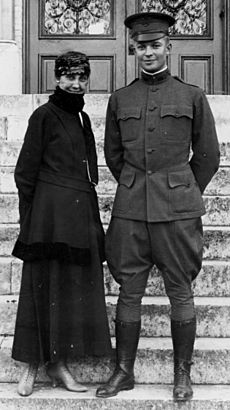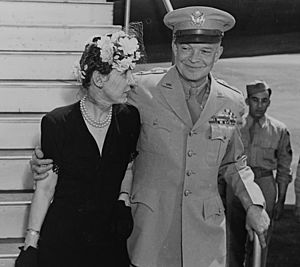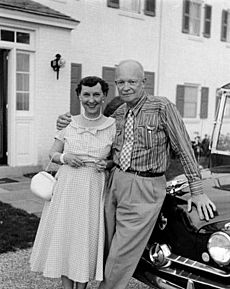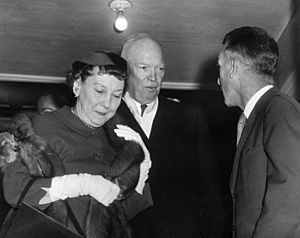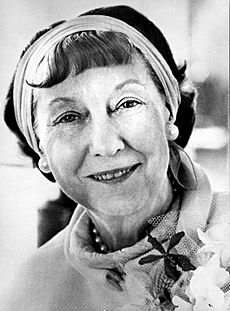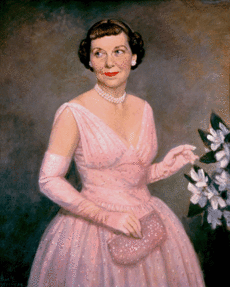Mamie Eisenhower facts for kids
Quick facts for kids
Mamie Eisenhower
|
|
|---|---|

Eisenhower in 1954
|
|
| First Lady of the United States | |
| In role January 20, 1953 – January 20, 1961 |
|
| President | Dwight D. Eisenhower |
| Preceded by | Bess Truman |
| Succeeded by | Jacqueline Kennedy |
| Personal details | |
| Born |
Mary Geneva Doud
November 14, 1896 Boone, Iowa, U.S. |
| Died | November 1, 1979 (aged 82) Washington, D.C., U.S. |
| Resting place | Dwight D. Eisenhower Presidential Library, Museum and Boyhood Home |
| Political party | Republican |
| Spouse | |
| Children |
|
| Signature | |
Mary Geneva "Mamie" Eisenhower (born Doud; November 14, 1896 – November 1, 1979) was the First Lady of the United States from 1953 to 1961. She was the wife of President Dwight D. Eisenhower. Mamie was born in Boone, Iowa, and grew up in a wealthy family in Colorado.
She married Dwight D. Eisenhower in 1916. He was a lieutenant in the Army at the time. As an Army wife, she moved often with her husband. They lived in many places, including the United States, Panama, the Philippines, and France. She became well-known during World War II as the wife of General Eisenhower.
As First Lady, Mamie Eisenhower managed the White House staff and budget. She was known for being careful with money. She hosted many important guests from other countries. Mamie was not very interested in politics. However, she supported soldiers and civil rights causes. She was very popular during her time as First Lady. She was also seen as a fashion icon, known for her bangs and love for the color pink. Mamie and Dwight Eisenhower were married for 52 years. She passed away in 1979.
Contents
Mamie Eisenhower's Early Life
Mary Geneva "Mamie" Doud was born in Boone, Iowa. She was the second child of John Sheldon Doud and Elivera Mathilda Carlson. Her father was a successful businessman in the meatpacking business. Her mother's parents were Swedish immigrants.
Mamie grew up in several places, including Cedar Rapids, Iowa, Colorado Springs, Colorado, Denver, Colorado, and San Antonio, Texas. Her family was wealthy and had servants. This meant Mamie did not learn much about housework growing up. She had three sisters. Sadly, her older sister Eleanor died at age 17. As a child, Mamie had a serious illness called rheumatic fever. This made her health a concern throughout her life. Her father taught her how to manage money and budgets. She also traveled a lot with her family. She went to Wolcott School for Girls for finishing school.
Marriage and Family Life
Meeting and Marriage
Mamie Doud had many people who wanted to date her. But in 1915, she met Dwight D. "Ike" Eisenhower. He was a second lieutenant in the Army. They met when Mamie's family visited a friend at Fort Sam Houston. Ike asked her to tour the base with him. She was immediately interested in him.
They started dating and got engaged on Valentine's Day in 1916. Ike first gave her a small ring from his West Point class. Later, he gave her a full-size ring and asked her father for permission to marry. Mamie always celebrated both Valentine's Day and Saint Patrick's Day as their engagement anniversaries.
Mamie's father agreed to the marriage. But he had one condition: Ike could not join the Army Air Service. He thought it was too dangerous. They decided to marry sooner because American entry into World War I seemed likely. They got married at Mamie's family home in Denver on July 1, 1916. After their honeymoon, they returned to Fort Sam Houston where Ike was stationed. Mamie also met Ike's brother, Milton S. Eisenhower, who became a good friend to her.
Life as an Army Wife
For many years, Mamie lived the life of an Army wife. This meant constantly moving as her husband was sent to different places. Over Ike's 37 years in the military, they lived in 33 different homes. Their military homes were often small. Mamie had to furnish them and make them comfortable. The Eisenhowers often hosted guests wherever they lived. Their home became known as "Club Eisenhower." Mamie would attend social events with other officers' wives. She made many friends but avoided gossip.
Life as an Army wife was very different from her wealthy childhood. They lived on Ike's military pay, with some help from Mamie's father. Ike and Mamie were often apart because of his duties. Mamie sometimes felt sad and lonely during these times. Ike once told her that his duty would "always come first."
The Eisenhowers had two sons. Their first son, Doud Dwight "Icky" Eisenhower, was born in 1917. Mamie had to care for him on her own, which was very tiring. Sadly, Icky died from scarlet fever at age three in 1921. Mamie was heartbroken. Their second son, John Sheldon Doud Eisenhower, was born in Denver, Colorado, in 1922. John's birth helped Mamie feel better after her loss and the separations from Ike. She loved John very much. John later served in the military and became the United States Ambassador to Belgium. He also wrote several books.
In 1922, Ike was stationed in Panama. Mamie found the jungle environment difficult. She stayed in Denver for a while after John's birth. She rejoined Ike in Panama two months later with a nurse to help with the baby. Mamie learned to take an interest in Ike's career and support him. This helped their relationship. In 1928, she encouraged Ike to take a job in Paris. As Ike's career grew, Mamie hosted more important guests. When Ike became an aide to General Douglas MacArthur in 1929, the family moved to Washington, D.C.. Their home became a popular social spot.
In 1935, Ike was sent to the Philippines. Mamie stayed in Washington at first. Their relationship became strained. She joined him the next year. The family returned to the United States shortly after World War II began in 1939.
Wife of a General
During World War II, Ike became famous and was promoted. Mamie lived in Washington, D.C. Ike was in Europe for three years, and Mamie saw him only once. She helped with the war effort by volunteering for groups like the American Women's Voluntary Services and the United Service Organizations. Mamie worried constantly about Ike's safety. Reporters often bothered her, and she lost weight during the war. After the war, Ike's military success and his book, Crusade in Europe, brought the family financial stability.
In 1948, Ike became president of Columbia University. The Eisenhowers bought a farm in Gettysburg, Pennsylvania. This was the first home they ever owned. Mamie continued her hosting duties, entertaining university staff and important donors. Ike then became commander of North Atlantic Treaty Organization forces. They returned to Paris, which delayed work on their dream home until 1955. In Europe, they often hosted royal guests. Mamie received an award, the Cross of Merit, for her role in her husband's success.
When Ike decided to run for president in the 1952 election, Mamie helped him campaign. She seemed to enjoy campaigning and was popular with voters. She sometimes made public appearances without her husband's campaign managers knowing. She even suggested changes to his speeches.
First Lady of the United States
White House Hostess

Mamie Eisenhower became First Lady at a time when the role was becoming more public. She did not like the attention that came with the job. She believed her husband was the public figure, not her. She generally avoided duties outside the White House. She kept her distance from the press and rarely gave interviews. Her secretary, Mary Jane McCaffree, often spoke to reporters for her. She also refused to write a newspaper column. Mamie held only one press conference during her time as First Lady.
However, she was friendly with reporters when they met. She insisted they call her "Mamie." She also liked photographers and was happy to pose for them. Mamie personally replied to every letter she received. She sometimes shared concerns from these letters with others.
Despite her dislike for public life, Mamie enjoyed being a hostess. As First Lady, she entertained leaders from many countries. In total, she hosted about 70 official foreign visitors. She was a skilled hostess, thanks to her many years as an Army wife. She hosted social events full-time and enjoyed the traditions of the presidency. Mamie was praised for her social skills. She greeted and shook hands with thousands of people. When entertaining, she focused on comfort and popular tastes. She often had male quartets and musicians like Fred Waring perform for guests.
The media usually reported positively about Mamie Eisenhower. They focused on her personality and charm, not on politics or rumors.
Managing the White House
Mamie Eisenhower was naturally good at managing the White House and its staff. She used her experience as an Army wife. At first, she had a difficult relationship with the staff. She set many rules to make them more like traditional house staff. She also managed them very closely. But over time, she built good relationships with the staff. She treated them like family and even celebrated their birthdays. When their house in Gettysburg was finished in 1955, they had a housewarming party for the White House staff.
Mamie often managed the White House from her bedroom. She sometimes stayed in bed due to her health. The Eisenhowers divided their duties, and Mamie had full control over house spending and scheduling. She had learned to be very careful with money as an Army wife. She managed White House expenses down to small details. She was known for being frugal and even clipped coupons for the White House staff. Her recipe for "Mamie's million dollar fudge" became very popular. Many publications printed it.
During her time, she had several rooms redecorated in her favorite colors: pink and green. Mamie was especially active during the Christmas season. She had the White House heavily decorated and bought gifts for the staff. In 1958, she was also reported to be the first to decorate the White House for Halloween. It was hard to decorate the White House because there was not much government money for it. Many of her changes relied on private donations. She spent a lot of time on the flower arrangements, favoring gladiolus plants. She was very particular about White House decor. She loved the building itself, saying she "never drove up to the south portico without a lump coming to [her] throat."
When Ike had a heart attack in 1955, Mamie helped him get medical attention. After that, she took care of him. She limited his work schedule, managed his diet, and handled his mail. She also set aside a room upstairs where he could paint. She gave him strong emotional support when he was ill. When it was unclear if Ike would run for a second term in 1956 because of his health, Mamie encouraged him to run. She was very protective of her husband during his illnesses. Mamie also had her own health issues. She had trouble with her balance due to Ménière's disease. This is an inner-ear disorder that affects balance.
Mamie's Role in Politics
Mamie Eisenhower had little interest in the political side of the presidency. She was never directly involved in her husband's decisions. She entered the West Wing of the White House only four times during his presidency. This lack of political involvement helped her avoid media criticism. It also made her more popular.
Her main interest was social issues. These included women's issues and civil rights. She wanted to see more women elected to Congress. She also supported several women's clubs. She made sure to invite Black women to the White House. These included Marian Anderson and the National Council of Negro Women. She also supported causes like soldiers' benefits, civil defense, blood drives, and the United Nations. After her husband's heart attack, she helped raise money for the American Heart Association. The president sometimes asked her for advice on money matters. He had relied on her for finances throughout their marriage.
Mamie's control over the guest list and social schedule gave her some political influence. For example, when organizing the 1953 vice president's dinner, she invited every senator except Joseph McCarthy. This allowed the president to keep his distance from the controversial senator without taking a public stance. When the President of Haiti visited, she made sure he received full honors. This celebrated the first Black head of state to visit the White House. Most of her influence came through her social role. She made an effort to know the president's cabinet members and staff. She congratulated them and their wives to boost morale.
Mamie was reportedly unhappy about John F. Kennedy becoming president after her husband. She also expressed displeasure about the new First Lady, Jacqueline Kennedy. She called Mrs. Kennedy "the college girl." Jacqueline Kennedy had just given birth to her son, John Jr., by C-section two weeks before a planned White House tour. Mamie Eisenhower did not tell Jacqueline Kennedy that a wheelchair was available for her to use. Jacqueline Kennedy kept her composure during the tour. But she collapsed in private after returning home. When asked why she did this, Mamie Eisenhower simply said, "Because she never asked."
Later Life and Legacy
In 1961, Mamie and the former president retired to their farm in Gettysburg. This was their first permanent home. They also had a retirement home in Palm Desert, California. Mamie made occasional public appearances for the Kennedy administration. These included a fundraiser for the National Cultural Center. She also attended a state dinner with the Prime Minister of Japan.
As her husband was dying, a law was passed. It guaranteed lifetime Secret Service protection for presidential widows. When Ike died in 1969, Mamie went to Belgium. Their son was serving as ambassador there. After returning to the United States, she continued to live on the farm. Later, as her health declined in the late 1970s, she took an apartment in Washington, D.C. She often stayed in her bedroom after her husband's death. Secret Service agents supported her.
Mamie remained close with the Nixon family. Her grandson married the Nixons' daughter in 1968. She appeared in a commercial to support Richard Nixon's reelection in the 1972 election. The Nixons often invited Mamie to the White House during Nixon's presidency. Later in life, she took stronger political stances. She supported the Vietnam War. She also opposed the women's liberation movement. She supported Dick Thornburgh for governor of Pennsylvania. She also supported George H. W. Bush in the 1980 Republican Party presidential primaries. In 1973, Mamie Eisenhower explained her vertigo.
Mamie Eisenhower's Death
Mamie Eisenhower had a stroke on September 25, 1979. She was taken to Walter Reed Army Medical Center. This was the same hospital where her husband had died ten years earlier. Mamie stayed in the hospital. On October 31, she told her granddaughter Mary Jean that she would die the next day. She passed away in her sleep on the morning of November 1. This was just 13 days before her 83rd birthday. A memorial service was held on November 5. Many important people attended, including the Nixons and Rosalynn Carter. She was buried next to her husband in his hometown of Abilene, Kansas.
Mamie Eisenhower's Impact on Fashion
Mamie Eisenhower was known for her great sense of fashion. Many women copied her style. The New York Dress Institute named her one of the twelve best-dressed women in the country every year she was First Lady. Her style was called the "Mamie Look." It included full-skirted dresses, pink gloves, charm bracelets, pearls, small hats, purses, and bobbed hair with bangs. Her fashion was linked to Dior's "New Look" after the war. She wore both expensive and affordable items. Her careful spending habits affected her style. She often looked for bargains and kept her clothes for a long time.
Mamie wore a Nettie Rosenstein gown to the 1953 inaugural balls. It was a pink silk gown with over 2,000 rhinestones. This gown is one of the most popular in the Smithsonian National Museum of American History's collection of inaugural gowns. She wore matching gloves and jewelry. Her shoes had her name printed inside. Mamie first got her famous bangs when Ike was in Panama. She found the hairstyle helped her stay cool in the tropical weather. She kept it after returning to the United States. She owned many cosmetics and perfumes. She often visited a beauty spa to keep up her appearance. Mamie's love for a specific shade of pink, sometimes called "First Lady" or "Mamie" pink, started a national trend. People bought pink clothing, housewares, and even painted their bathrooms pink.
Historical Views of Mamie Eisenhower
Mamie Eisenhower is remembered differently from other First Ladies. She was not a traditionalist like Bess Truman. She was also not an activist like Eleanor Roosevelt. Her time as First Lady was when the role was changing and becoming more important. She had limited influence on the Eisenhower administration. She kept a clear line between her husband's public life and their home life. To the public, she represented the glamour and growth of the United States in the 1950s. She played the role of the "perfect wife" of her time. She was seen as very feminine, supportive of her husband, and focused on the home.
Mamie Eisenhower's most important impact on the role of First Lady was creating a dedicated personal staff. This staff later became the Office of the First Lady of the United States.
Since 1982, Siena College Research Institute has surveyed historians about American First Ladies. They rate them on things like their background, value to the country, intelligence, and leadership. Mamie Eisenhower has been ranked:
- 31st-best of 42 in 1982
- 17th-best of 37 in 1993
- 27th-best of 38 in 2003
- 19th-best of 38 in 2008
- 24th-best of 39 in 2014
In a 2014 survey, historians felt Mamie Eisenhower was third among 20th and 21st-century First Ladies who could have done more. In the same survey, Mamie and her husband were ranked 14th out of 39 first couples as a "power couple."
See also
 In Spanish: Mamie Eisenhower para niños
In Spanish: Mamie Eisenhower para niños


